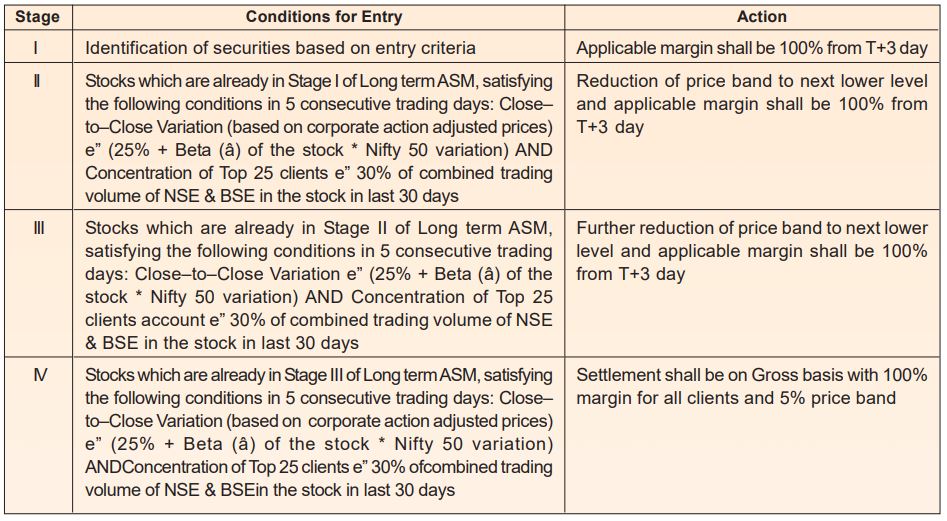The investor cannot be faulted for losing track of the various surveillance measures introduced by SEBI. Though all such measures are aimed at ensuring stock market’s integrity, some gets lost in translation, some are too complex to grasp right away, but more often than not, the investor carries on without getting too much perturbed by them for long. But, with the rise in stock market activity, both in terms of price rise as well as participation, some of these measures, do grab the investor’s attention especially when it affects the smooth flow of trading. One such measure is ASM or Additional Surveillance Measure.
Broad short-listing criteria
The shortlisting of securities for placing in ASM is based on an objective criterion as jointly decided by SEBI and Exchanges covering the following parameters:
• High Low Variation
• Client Concentration
• Close to Close Price Variation
• Market Capitalization
• Volume Variation
• Delivery Percentage
• No. of Unique PANs
• PE
When does a stock enter ASM list
There are SEVEN criteria for selection of stocks under the Long Term ASM Framework.
- High–Low Price Variation (based on corporate action adjusted prices) in 3 months > (150% + Beta () of the stock * Nifty 50 variation) AND Concentration of Top 25 clients) of the stock * Nifty 50 variation). AND Concentration of Top 25 clients) of the stock * Nifty 50 variation) AND High–Low Price Variation (based on corporate action adjusted prices) in 365 days > (200% + Beta () of the stock * Nifty 50 variation) AND Market Capitalisation > Rs. 500 Crore as on review date AND Concentration of Top 25 clients) of the stock * Nifty 50 variation) Exemption: Bulk / Block (maximum of buy /sell value), i.e., Average Volume of Bulk or Block Quantity / Average Volume of the Security greater than 50%.
What happens after a stock enters ASM category?

5.Close to Close price variation > 25% + (Beta * Nifty 50 Variation) in a month AND PE negative OR > 2 times of PE of Nifty 50 AND Market Capitalisation < Rs. 500 Crores as on review date.
6.Close-to-Close price variation of the SME stock ) of the stock * NIFTY SME EMERGE Index Variation) in 15 days OR Close-to-Close price variation of the SME stock ) of the stock * NIFTY SME EMERGE Index Variation) in 30 days OR Close-to-Close price variation of the SME stock ) of the stock * NIFTY SME EMERGE Index Variation) in 3 months AND PE of the stock is negative OR PE of the stock ) of the SME stock * NIFTY SME EMERGE Index Variation) shall be considered. ii. Concentration of Top 25 clients excluding market makers shall be considered.
7.Scrips with price band of ±10%, ±5%, ±2% AND Close[1]to-Close Price Variation (based on corporate action adjusted prices) in 365 days) of the stock * Nifty 50 variation) AND High-Low Price Variation (based on corporate action adjusted prices) in 365 days) of the stock * Nifty 50 variation) AND Market Capitalisation > Rs. 1000 Crores as on review date AND Concentration of Top 25 clients. (Refer NSE Circular – NSE/SURV/48506 dated June 04, 2021)
What greets the investor?
To a normal investor, the announcement of a particular stock moving into ASM list, will appear to lend a negative air to the stock. This need not be the case always but let us see why price declines may follow shortly after the announcement. For one, the prospects of continuation of the ongoing rapid rise quickly recede, as the price band gets lowered. Secondly since such stocks move into the trade to trade segment, intraday traders will not touch it sucking out a good amount of liquidity. Lastly, since 100% margin is required, traders who have been riding the froth in prices with leveraged money will also scoot. When the leveraged positions unwind, some buy and hold traders also choose to book some profits leading to a downtrend for the next few days. This is more of a cooling period and serves as a test of the stock’s mettle.
At times, this is enough to break the back of the momentum. But more often than not, especially if the fundamentals still appear promising, or traders still like the stock, the stock swings back to the upside trajectory, as soon as it is lifted off the ASM list. For this reason, traders and investors alike have begun to routinely follow both entry into and exit from the ASM list and adjust their positions. For good measure, ASM asks questions that the market knows already, but it certainly provides a breathing to reascertain one’s positions.







